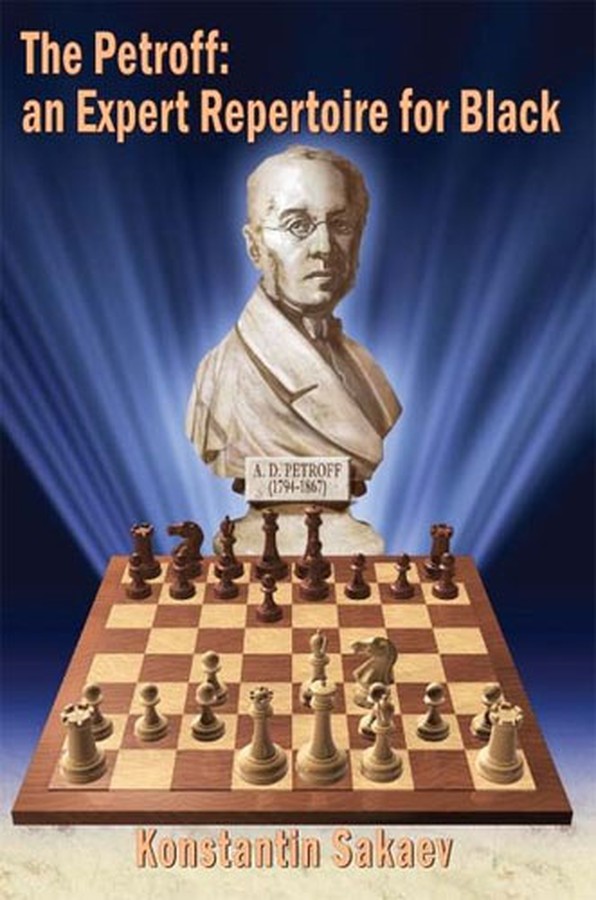| Nivå | B-D |
| Utgivelsesdato | September 2011 |
| Forfatter | |
| Pris | 275 NOK |
The Petroff: an Expert Repertoire for Black
Russisk 1 e4 e5 2 Sf3 Sf6 er kjent som et solid våpen, men har vært under et visst press i senere år, så de fleste spiller nå 2...Sc6. Den sterke stormesteren Sakaev gir her svartspilleren pålitelig ny input med 2...Sf6.
Navnet på boka indikerer at dette er stoff og analyser som skal holde vann også for spill på høyt nivå. Men presentasjonen av boka er så ryddig og behagelig at også spillere med lavere ratingstyrke kan benytte den med glede, bare med grundigere arbeid for å sette seg inn i variantene til eget bruk.
På flere språk, blant annet engelsk, har åpningen fått navnet sitt etter den tidligere store russiske sjakkmester Aleksander Petroff (1794-1867).
Som repertoarbok finnes her også korte og etter forfatterens mening gode oppskrifter mot hvits alternative trekk 2 f4, 2 Lc4, 2 Sc3 og 2 d4.
Forfatterens forord
The Petroff Defence is an exceptionally reliable and almost indestructible opening, and a hard nut to crack, even for the strongest and most meticulously prepared grandmasters theoretically. It is no accident that the Petroff Defence, named after its inventor and also know as the Russian Game, has for many years been the main opening weapon of Vladimir Kramnik and Boris Gelfand and has also been played regularly by Vishy Anand and Alexey Shirov. Nowadays there are also several very young and talented grandmasters who play it, such as Wesley So and Anish Giri. Anatoly Karpov and Artur Yusupov have been using it as a part of their opening armoury throughout their chess careers... The list could go on and on.
The Petroff Defence is characterised by the fact that on his second move Black does not protect his e5-pawn, but instead counter attacks with 2...Nf6, proposing to the opponent the immediate exchange of a pair of pawns, thus slightly simplifying the position and quickly defining the future pawn-structure.
What are the pluses and minuses of an opening repertoire based on the Petroff Defence, such as we are recommending in this book? I think I can see only one drawback. If White is an experienced player with a good grasp of theory, and he is in the mood to draw, then he should be able to share the point without too much problem. Still, the same can also be said about almost every other opening, because in contemporary chess it is tremendously difficult to win with Black unless White makes a serious mistake. On the other hand, there is a great advantage to consider: you will not obtain bad positions from the opening. The Petroff Defence is particularly suitable for players with a positional style, since in a calm, quiet contest you can easily win the game if the opponent takes too many risks. You can see this illustrated in the Complete Games section.
I have endeavoured to present and explain to you all the finer points of this opening, as I understand them. In general, the critical positions have been treated thoroughly and I have also suggested and analyzed a great many new ideas in this book. Some variations which have amassed considerable tournament practice, but which, in my view, are less principled, have been covered only briefly. Otherwise, the book would have become too big, losing its essential purpose. Unfortunately, too many authors write chess books in that way; they offer no original analysis and often quote outdated games, some of which are very weakly played and almost useless.
I hope that you, the reader, will enjoy studying this book, and I wish you wonderful tournament results with this opening!
Konstantin Sakaev, Saint Petersburg 2011
| Innbundet? | Nei |
| Type | Bok |
| Språk | Engelsk |
| Antall sider | 292 |

